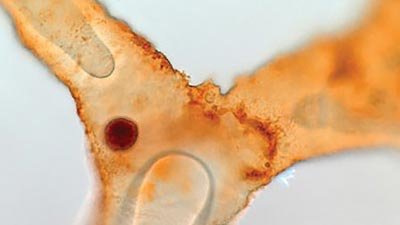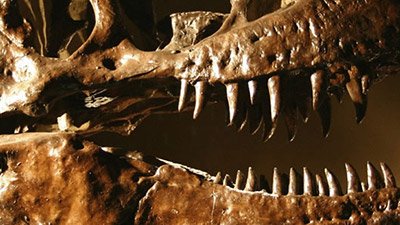Origins of the Giants
South American sauropodomorph fills in the gap.
News Source
- Smithsonian: “Leyesaurus and the Origins of Giants”
Everyone is impressed by gigantic Jurassic and Cretaceous sauropods. As paleontologists search for the evolutionary ancestors of these giants, they look to the Triassic layer just below. Since they believe the geologic column is a vertical timeline of evolutionary origins, they believe the Triassic, Jurassic, and Cretaceous layers were laid down over millions of years and contain the giants’ evolutionary history. The somewhat smaller sauropodomorphs of the Triassic and Lower Jurassic periods have sufficient similarities (and differences) to big sauropods to fit the ancestral role.
South American paleontologists have recently added two sauropodomorphs to the catalogue of Triassic diversity. Two years ago Panphagia was added to the list as a 231 million year old Argentine ancestor. Now, Argentine paleontologists report their discovery of another sauropodomorph they believe will fill in a gap in South American sauropod history by confirming the worldwide distribution of their diverse ancestors.
This partial skeleton was found in Quebrada del Barro rock in northwestern Argentina. Those rocks were previously dated as Cretaceous or upper Triassic on the basis of a single dinosaur foot fossil that was poorly documented, according to the authors of the current study.1
Because the new fossil’s pieces—“a skull, several neck and tail vertebrae, and a few elements of the limbs”—closely resemble the early Jurassic South African sauropodomorph Massospondylus—the authors have re-dated Quebrada del Barro as early Jurassic, somewhat younger than the previous estimate. Since some rock layers in the Marayes-El Carrizal Basin, of which the Quebrada del Barro forms the top, are not represented, those that are present are dated according to the fossils present—which of course are normally dated according to the rock layers in which they are found. Thanks to its South African “cousin’s” dates, this new fossil is thought by evolutionists to be 199 million years old.
There are not enough bones of the new fossil to actually tell how the original owner walked, but since the hindlimbs are not like the ponderous columns of sauropods and since the South African “relative” has forelimbs shorter than hindlimbs, researchers infer their specimen alternated between bipedal and quadrupedal locomotion. However, there are enough unique features to allow the fossil its own name, Leyesaurus marayensis. It is estimated to have been about 8 ½ feet long. While the discoverers do not believe it was a direct ancestor of the giant sauropods, they believe it was part of a diverse group found all over the world and that some sauropodomorphs were the predecessors of the giants.
The interpretation of this fossil and many similar fossils of the Triassic and Lower Jurassic as a group preceding the Late Jurassic and Cretaceous giants by millions of years is based on the evolutionary worldview that rejects other explanations for the geologic column. The global Flood explains the geologic column as a record of the order in which organisms were buried. These sedimentary rock layers are generally dated according to the supposed ages of the fossils found in them, although sometimes they are dated using radiometric dating methods applied to nearby igneous rocks. Those methods have their own set of unverifiable assumptions. (See “Radiometric Dating: Back to Basics,” “Radiometric Dating: Problems with the Assumptions,” “Radiometric Dating: Making Sense of the Patterns.”)
Even when those fossils are dated according to their similarity with fossils elsewhere in the world—as was done here at the cost of a few million years to Quebrado del Barro—the reasoning is based on the assumption that creatures really did evolve and did so all over the world at about the same rate.
With fossils dated according to the layers and the layers dated according to the fossils in them, the circular reasoning is obvious. Furthermore, even when those fossils are dated according to their similarity with fossils elsewhere in the world—as was done here at the cost of a few million years to Quebrado del Barro—the reasoning is based on the assumption that creatures really did evolve and did so all over the world at about the same rate. This worldview ignores the Flood model’s consistency with the worldwide presence of similar rock layers laid down along with the remains of creatures rapidly buried. Even the similarity of fossils in corresponding layers is consistent with the fact the some animals—like larger dinosaurs—would have been able to flee the floodwaters for a time and ultimately be buried later—in higher layers.
From Genesis chapter 7 we know that the Flood involved cataclysmic upheavals in addition to rain. These conditions would have produced surges of rising water that took quite some time to reach maximum depth. After these surging waters carrying sediment engulfed various creatures, they settled to produce layers in the geologic column.
The authors of the study are quite justified in admiring the diversity of creatures preserved in the Triassic and Jurassic layers. But they err in their assumptions of when and how they came to be there. The Bible’s history is consistent with geologic and biologic records.
Further Reading
- Transcontinental Rock Layers
- Order in the Fossil Record
- Geologic Column
- Doesn’t the Order of Fossils in the Rock Record Favor Long Ages?
For More Information: Get Answers
Remember, if you see a news story that might merit some attention, let us know about it! (Note: if the story originates from the Associated Press, FOX News, MSNBC, the New York Times, or another major national media outlet, we will most likely have already heard about it.) And thanks to all of our readers who have submitted great news tips to us. If you didn’t catch all the latest News to Know, why not take a look to see what you’ve missed?
(Please note that links will take you directly to the source. Answers in Genesis is not responsible for content on the websites to which we refer. For more information, please see our Privacy Policy.)
Footnotes
- Cecilia Apaldetti, Ricardo N. Martinez, Oscar A. Alcober, and Diego Pol, “A New Basal Sauropodomorph (Dinosauria: Saurischia) from Quebrada del Barro Formation (Marayes-El Carrizal Basin), Northwestern Argentina,” PLOS One, November 9, 2011, http://www.plosone.org/article/info:doi/10.1371/journal.pone.0026964.
Recommended Resources

Answers in Genesis is an apologetics ministry, dedicated to helping Christians defend their faith and proclaim the good news of Jesus Christ.
- Customer Service 800.778.3390
- © 2024 Answers in Genesis








